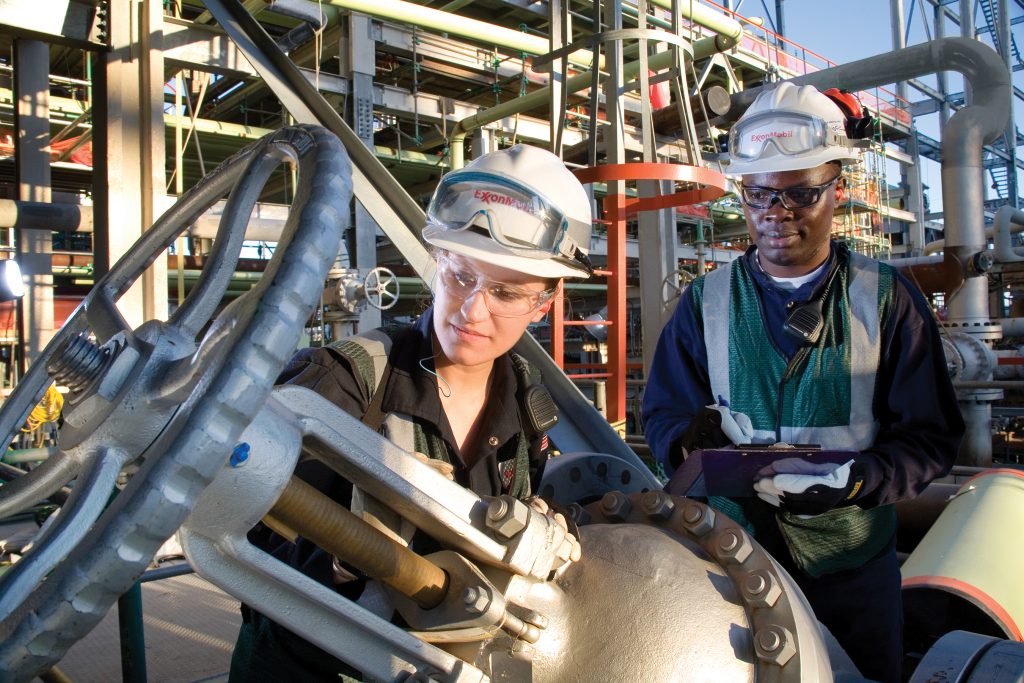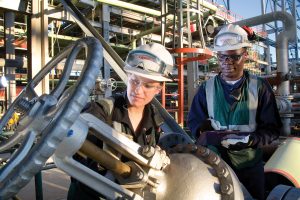
Does your oil and lubrication program ensure your equipment is running at its best?
August 10, 2016 | By Rehana Begg
 "At our plants worldwide, operating and maintenance procedures are developed and used to ensure reliable and safe operations."
"At our plants worldwide, operating and maintenance procedures are developed and used to ensure reliable and safe operations." 
Source: www.mobilindustrial.com
Most plant managers ask themselves how they can extract every ounce of productivity from their equipment to ensure that the plant is as efficient, safe and profitable as possible.
The answer: Doing as much as you can to protect your equipment.
It is true that nearly all industrial operations already have formalized maintenance programs in place for their equipment. But, these operations are becoming increasingly large and complex, utilizing dozens of different pieces of industrial equipment. Further, equipment technology is advancing at a rapid pace while energy efficiency regulations are becoming more stringent.
Simple maintenance approaches of the past, such as those designed around individual pieces of equipment or those that rely solely on guidance provided by equipment builders, no longer suffice. Similarly, approaches that only consider lubricant products and not associated technical services result in missed opportunities to maximize equipment efficiency.
And so, in this environment, plant managers must look at their maintenance approach and determine whether their maintenance programs are robust enough to properly protect their equipment.
To help ensure that equipment is performing at its best, look beyond individual pieces of equipment and look toward the core productivity challenges facing the operation. Once one understands the problems that need to be solved, one can develop a tailored maintenance program that closes any existing productivity gaps and optimizes the performance of each piece of equipment.
This approach can help minimize unscheduled equipment downtime and enhance equipment performance, thus helping you better achieve your productivity, safety and environmental care goals.
Let’s take a closer look at how these end-to-end programs are developed. There are two key pillars of any successful maintenance program – high performance lubricant products and expert technical services. A best practice approach will bring these individual components together into a cohesive program that addresses the specific productivity gaps in an operation.
High performance lubricants
The first pillar of any successful maintenance strategy is selecting the right lubricants. Today’s advanced equipment requires high-performance lubricant technologies that can help protect machinery from extreme operating conditions often found in industrial operations.
While there is a wide range of lubricant technologies available to equipment owners, synthetic lubricants are ideally suited for most advanced equipment as they can offer significant advantages over conventional, mineral-based lubricants.

Take, for example, hydraulic systems. Hydraulic equipment is often subject to pump wear, deposits, and varnish, and these challenges will prevent the systems from operating at their rated performance level, often resulting in decreased speed and pressure. But, utilizing premium or synthetic hydraulic oils can help address these challenges, as they have been proven to offer outstanding contamination control, exceptional wear protection, and cleanliness that lasts.
Similarly, malfunctioning ejector pins can cause parts to stick inside the mould, sending them to the scrap heap for regrinding. Poor hydraulic clamping pressure can have the same effect, but by converting operations to high quality grease, operators can potentially reduce ejector pin wear, reducing instances of quality loss.
Thus, understanding the benefits of various types of oils – particularly synthetic oils – can help deliver significant performance benefits for equipment. And to choose the right product, plant operators must consider the specific performance and productivity needs of their operation. The table below outlines various types of synthetic oils and the distinguishing properties of each:
| Type of Synthetic | Key Properties |
| Polyalphaolefins (PAOs) | · Most common type of synthetic base oil
· Used in nearly every type of industrial equipment · Miscible with mineral oils · Exhibit good demulsibility properties |
| Polyalkylene Glycol Oils (PAGs) | · Exhibit limited demulsibility with mineral oils
· Don’t form deposits as the oil breaks down |
| Esters | · Help with additive solubility
· Remain fluid at low temperatures due to a high viscosity index and low pour point |
| Silicone Base Oils | · Offer some of the highest levels of thermal and oxidative stability
· Used in high heat applications · Chemically inert, making it difficult to blend additives into them and still have them |
Note that it can often be helpful to work with a lubricant supplier to identify the best product mix for the operation.
Expert technical services
In addition to selecting the right products, plant operators must also take advantage of expert technical services to ensure that their equipment is performing at its best.
Services are sometimes underutilized in maintenance programs, but they are an important part of making sure the equipment is running well. For this reason, many leading lubricant suppliers offer a range of data-based services that can help operators improve the effectiveness of their lubrication programs.
For example, oil analysis programs – a more commonly used service – can help optimize equipment performance by providing the data needed to maximize the life of equipment and ensure that it is maintained properly.
However, more advanced oil analysis platforms can provide even more helpful insights, including reviews and documentation to validate used oil analysis results. They can also help explain and guide implementation of necessary remediation steps, ensuring customers fully understand the used oil analysis and can take proper actions to keep their operation safe and productive.
Finally, the most advanced used oil analysis platforms can help customers identify high-level trends not typically seen when viewing individual sample reports, with summaries that help customers understand the health of their equipment detailed by alarm, equipment type, products in use, application and operation.
These are just a few examples of services that can provide plant operators with a comprehensive, application-specific solution to address their productivity challenges and ensure that their efforts to boost productivity are continuously supported.
Building a maintenance plan to suit your needs
Selecting the right mix of products and services is critical to the success of any maintenance plan, but understanding how to build that plan based on your productivity gaps requires extensive application expertise.

Plant operators understand the specifics of their operation and its challenges better than anyone else, but to best understand equipment performance, it can often be helpful to work with maintenance partners such as lubricant suppliers, as they can provide invaluable insight into today’s equipment maintenance needs and help identify the tools to help support those needs. Sometimes, this insight comes from firsthand experience working with equipment builders.
In general, however, building an effective maintenance program that addresses the productivity gaps facing the entire operation involves four main steps:
- Understand the business goals: The first step to developing a comprehensive lubrication program is to identify core business goals. For example, what are the safety, sustainability and productivity goals for the operation? How will their success be measured? What is the timeline to accomplish these goals? These are important questions to consider before designing a maintenance program, as they will influence the tactics used in the final approach. Once the goals are set, one can develop a roadmap to achieve them.
- Evaluate existing maintenance and lubrication practices to identify gaps: With the goals defined, the next step is to evaluate existing maintenance and lubrication practices. Often, the lubricant supplier’s insight can prove helpful here, as they will be able to provide the tools and resources needed to accurately evaluate existing practices, such as on-site inspections or used oil analysis platforms. This process will enable one to identify any productivity gaps in the operation. For example, one can determine if the plant is experiencing more unscheduled downtime than it should be, or one can evaluate if equipment oil drain intervals are shorter than they should be. These insights will guide the next step in the process.
- Develop an end-to-end maintenance program: After assessing the current state of the existing program, one should have the insights needed to develop a predictive maintenance program that closes existing productivity gaps and delivers optimal protection for the equipment. Collaborating with a lubricant supplier is recommended for this step. As discussed previously, there is a wide range of tools and machinery involved in industrial operations, including compressors, pumps, gearboxes and generators.
The lubricant supplier has likely worked closely with Original Equipment Manufacturers (OEMs) on developing tailored lubrication strategies for each of those pieces of equipment. With that experience, they can help develop a plan that includes the best fit-for-purpose lubricant technologies and expert technical services that are needed to optimize the performance of all equipment within the operation. In sum, they can help greatly simplify an often complex issue.
- Implement and monitor the tailored maintenance program: The final step is to implement the tailored maintenance plan. But, ensuring the plant operates at optimal productivity does not end with implementation alone. It is important to continually monitor the condition of equipment and the success of the maintenance program, using some of the technical services referenced above to ensure the equipment is performing at its best. Developing an effective maintenance plan is an intensive process, but working with relevant partners – who have the appropriate application expertise – can help make this process simpler and more efficient.
Maintenance critical to profitability
The link between productivity and profitability has been well defined, and in today’s environment, when stakeholders are facing increasing costs and thinning margins, every gain in productivity is critical to ensuring success.
While proper maintenance strategies are already a core part of any industrial operation, their importance cannot be overlooked when it comes to advancing productivity. In fact, previous studies have demonstrated that in large operations, reducing maintenance expenditure by $1 million can impact profitability as much as increasing sales by $3 million.
As a result, it is imperative that plant operators dedicate the necessary resources and effort to optimize equipment performance. Taking a careful approach to developing a maintenance plan – one that starts by identifying productivity gaps before considering equipment maintenance – is an effective way to optimize the productivity of the operation. And most importantly, plant operators should leverage as much application expertise as possible when developing their maintenance plan.
Utilizing this approach, plant operators can help mitigate the impact of industry challenges and optimize their operation’s performance to help achieve their productivity, safety and business goals.
This article was published in the June 2016 issue of Machinery and Equipment MRO magazine. Alan Suan is industrial marketing advisor at ExxonMobil Fuels & Lubricants. For more information, visit www.mobilindustrial.com.
